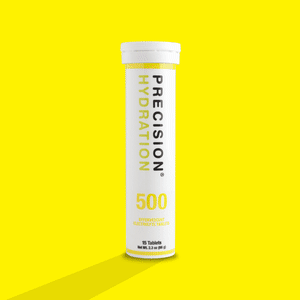Before we started developing our range of electrolyte supplements, we looked around at pretty much all the hydration products on the market and noticed that there was no clear and consistent way of communicating how much sodium - the crucial ingredient when it comes to hydration - was in a product.
So, we explain why we name our products according to their relative concentration...
How do you know how much sodium is in a sports drink?
Some sports drinks label the "Salt" content of the supplement, which can be misleading as the % of "Salt" that’s actually sodium depends on the type of salt used.
For example, sodium chloride (aka common 'table salt', which is commonly used in sports drinks) is only 39% sodium and 61% chloride. So, a drink with 1g of Salt (in the form of sodium chloride) actually only contains 390mg of sodium, not the 1g (1000mg) you might assume from a quick read of the nutritional info table.
Other labels display the salt or sodium content "per serving", which varies wildly from product to product - with dosage advice like "1 or 2 tablets per 750ml (24oz)" being pretty typical - whereas others displayed it "per tablet” or “per packet” (when in fact 1 serving = 2 tablets/packets) etc etc.
All of this made it really hard to tell how much sodium was in a particular supplement and to compare one sports drink to another to figure out which one was the right option for your specific needs before, during or after a given event or training session.
What is relative concentration?
So we decided that we’d make a stand and actually name our products according to the relative concentration of sodium in each drink when it’s mixed as directed.
As a result, our products are simply called PH 250, PH 500, PH 1000 and PH 1500.

So, in the example of PH 1000, you get a solution with exactly 1000mg of sodium per litre (32oz) if you mix them as directed, that's 1 tablet or packet into 500ml (16oz) of water.
This is the most appropriate way to express the sodium concentration of a solution. It’s also a commonly used way to communicate the sodium concentration of an athlete’s sweat. For example, my sweat sodium concentration is 1,800mg/l; as in I lose 1,800mg of sodium per litre (32oz) of sweat that I lose.
So, naming our products in this way enables you to easily match the fluid you’re putting back in (i.e. your electrolyte drink) with the concentration of the fluid you’re losing through sweating.
In my case, I drink our strongest product, PH 1500, because it helps me replace a good perecntage of the electrolytes (1,800mg of sodium per litre/32oz) I’m losing in my sweat. As an aside, you don’t need to aim to replace 100% of the sodium/fluids you lose through your sweat.
It also helps to emphasise that, when it comes to staying hydrated, the most important thing about a sports drink is it’s sodium concentration.
That is, the net amount of sodium you consume should always be considered in relation to the amount of fluid you’re taking it in with, not just as an arbitrary amount of sodium on it’s own. In your body, sodium is always present in water, so trying to separate the two doesn't make a lot of sense in this context.
So, you shouldn’t be concerned with the net amount of sodium in an (arbitrary) single serving of a product, it’s all about the relative concentration of the fluid once you’ve mixed the supplement with the water.
For example, if you take our Sweat Test and discover that you lose ~1,750mg of sodium per litre (32oz) of sweat we'd be likely to recommend that you drink PH 1500 whenever you're sweating for more than a few hours.
Now, let's say you tend to carry a 500ml (16oz) bottle with you. So, you'd mix one tablet or packet of PH 1500 into your bottle and drink that to thirst when you're out sweating. In doing so, you'd be taking in 750mg of sodium with that 500ml (16oz) of fluid, but the important thing is that the concentration of your drink is 1,500mg per litre (32oz), which would be replacing an adequate proportion of the 1,750mg of sodium you're losing per litre of sweat.
Why is relative sodium concentration of sports drinks important?
The relative concentration of a drink aiming to keep you hydrated is crucial because it's a key factor in determining how your body absorbs and retains the drink after it passes your lips and enters your stomach, gut and on into your bloodstream.
That’s why we always recommend mixing our drinks up as directed and why many supplements end up being used wrong; people often mix them up in way too much water, diluting the concentration down and reducing their effectiveness in terms of rehydration.
The more sodium in a drink (relative to the volume of water it’s dissolved in), the higher the “osmolality” of that solution and the more easily it’s absorbed and retained in the blood plasma (up to a certain point at least).
This is because your blood is very salty (~3,200mg of sodium per litre/32oz) and this is tightly controlled by your body, so weaker drinks can only be absorbed so much before they start to dilute the level of sodium down, which your body doesn’t like.
So, that’s why we believe that labelling the products by their relative sodium concentration makes sense. It’d be nice to think that the wider sports drink industry might sit up and take notice of this idea one day and start to do something similar with product labelling in order to make it easier to compare one electrolyte supplement with one another.
That might be wishful thinking, but it’s definitely something we would welcome in the future!
